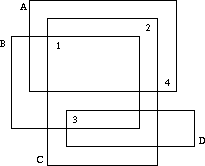POJ1486:Sorting Slides
点击打开题目链接
=====================================题目大意=====================================
有N张幻灯片堆在了一起,这一堆幻灯片上共有N个数字,这些数字与幻灯片是一一对应的。
但是由于幻灯片都是透明的,所以现在无法直接确定哪个数字属于哪张幻灯片。
现在告诉你这N张幻灯片和N个数字的位置,编程输出可以确定的数字和幻灯片之间的对应关系。
=====================================算法分析=====================================
将数字集合作为U,幻灯片集合作为V,数字u可能在幻灯片v上作为连接u和v的边。
一、二分图最大匹配。
根据题意可知,所建立二分图的最大匹配数就是N,且最大匹配方案可能有多种。
而u和v的对应关系确定,也就是说在所有最大匹配方案中,u的匹配点都是v。
那么如果删除连接u和v的边,二分图的最大匹配数一定会小于N,根据该思路编程即可。
二、贪心。
如果当前图中有“某个端点的度为1”的边,则该边所表示的对应关系便是确定的(这一点毋庸置疑),从图中删除该边的两
个端点后继续此操作。
在网上的题解和POJ的[Discuss]中发现有不少人这样做。
但是他们都没有证明确保这一算法正确的前提“所有点的度不小于1的二分图中任意去除一条边都不会使得最大匹配数减少”。
事实上这一点也不难证明,以下是浩神提供的思路。
首先求出二分图的最大匹配。
显然删除一条非匹配边是不可能使得最大匹配数减少的。
那么删除一条匹配边呢?首先这时候图中的匹配数会减一,另外不妨假设所删除匹配边的两个端点分别是u和v。
而由于图中所有点的度是不小于1的,这就意味着u和v一定同时位于某个环中,那么从u到v就不止“直接连接u和v的边”这一条路径。
所以虽然删除了从u到v的匹配边使得u和v变成未盖点,但此时我们又能找到另外一条从u到v的路径,而这条路径显然即增广路。
对增广路进行取反操作后图中的匹配数便会加1,那么前后图中的匹配数也就保持不变,也就是说最大匹配数并未减少。
觉得写起来麻烦,就不贴代码了。
=======================================代码=======================================
![]()
#include<stdio.h>
#include<string.h>
int N,Linker[50];
bool Edge[50][50],Vis[50];
struct RECT { int Xmin,Xmax,Ymin,Ymax; } Rect[50];
bool DFS(int U)
{
for(int v=1;v<=N;++v)
{
if(Edge[U][v]&&!Vis[v])
{
Vis[v]=true;
if(Linker[v]==-1||DFS(Linker[v]))
{
Linker[v]=U;
return true;
}
}
}
return false;
}
int Hungary()
{
memset(Linker,-1,sizeof(Linker));
int ans=0;
for(int u=1;u<=N;++u)
{
memset(Vis,0,sizeof(Vis));
if(DFS(u)) { ++ans; }
}
return ans;
}
void ReaData()
{
memset(Edge,0,sizeof(Edge));
for(int v=1;v<=N;++v)
{
scanf("%d%d",&Rect[v].Xmin,&Rect[v].Xmax);
scanf("%d%d",&Rect[v].Ymin,&Rect[v].Ymax);
}
for(int u=1;u<=N;++u)
{
int x,y;
scanf("%d%d",&x,&y);
for(int v=1;v<=N;++v)
{
if(!(Rect[v].Xmin<=x&&x<=Rect[v].Xmax)) { continue; }
if(!(Rect[v].Ymin<=y&&y<=Rect[v].Ymax)) { continue; }
Edge[u][v]=true;
}
}
}
int main()
{
int Case=1;
while(scanf("%d",&N)==1&&N)
{
ReaData();
printf("Heap %d\n",Case++);
bool first=true;
for(int v=1;v<=N;++v)
{
Hungary();
int u=Linker[v];
Edge[u][v]=false;
if(Hungary()!=N)
{
if(first) { first=false; }
else { printf(" "); }
printf("(%c,%d)",v-1+'A',u);
}
Edge[u][v]=true;
}
printf("%s\n",first?"none\n":"\n");
}
return 0;
}
